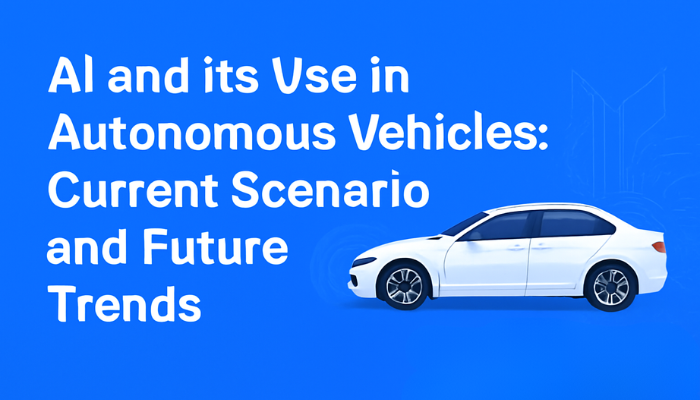Autonomous vehicles have transitioned from concept to reality. Companies like Tesla, Waymo, and Cruise now operate thousands of self-driving cars, and the market is expected to reach $556.67 billion by 2026.
This transformation is driven by AI advancements in machine learning, computer vision, and neural networks, which process sensor data in real-time, identify objects faster than human reflexes, and learn from millions of driving scenarios.
The impact goes beyond transportation. Business leaders face new opportunities and competitive threats. Product managers must design user experiences that build trust in autonomous systems, while investors assess which companies will lead the market. Designers are creating interfaces for driverless vehicles, and marketers need to explain complex AI capabilities to skeptical consumers.
Understanding the current and future role of AI in autonomous vehicles is essential for strategic positioning in this disruptive technology. Let’s explore the AI algorithms that help self-driving cars learn, adapt, and navigate safely.
Artificial Intelligence Algorithms Used in Self-Driving Cars
In autonomous vehicles, AI plays a critical role in enhancing fleet management, improving safety, and boosting operational efficiency. By using machine learning algorithms, businesses can reap significant benefits, from reducing costs to gaining a competitive edge in the market.
Let’s break down how these algorithms contribute to the making of autonomous vehicles:
Supervised Learning
Supervised learning is a type of machine learning where the algorithm is trained on a labeled dataset, meaning the correct output is already provided. These algorithms are trained on labelled datasets to reliably detect objects, road markings, and predict vehicle paths.
Business outcomes:
- Reduce accident rates by up to 70% through accurate pedestrian and obstacle detection
- Improve delivery route adherence, cutting operational delays
- Optimise fleet fuel consumption by reducing sudden braking and lane deviations
Unsupervised Learning
Unsupervised learning helps the vehicle adapt to unexpected scenarios, identifying hidden patterns and anomalies. It doesn’t rely on labeled data and is essential for enhancing safety and adaptability in dynamic environments. Key business impacts include:
Business Outcomes:
- Enhanced Safety: By detecting unusual situations such as vehicles deviating from their lane or pedestrians crossing unexpectedly, unsupervised learning ensures vehicles can act quickly to avoid accidents, enhancing customer safety and reducing potential liabilities.
- Flexibility in New Scenarios: AI enables the vehicle to recognize new road features and obstacles, adapting to unfamiliar environments. This adaptability leads to fewer service interruptions, reduced downtime, and the ability to operate across a wider range of geographical locations.
- Market Competitiveness: A fleet that can safely and efficiently navigate any environment, even without labeled data, gives your business a significant advantage in an increasingly competitive market.
Both supervised and unsupervised learning are essential for autonomous vehicles to function efficiently, safely, and adapt to real-world driving environments. These algorithms enable the vehicle to make split-second decisions, perceive the surroundings, and continuously improve its driving abilities as it learns from new data.
With the algorithms in place, let’s see how AI brings self-driving vehicles to life on the road.
How AI Powers Self-Driving Vehicles
Self-driving vehicles rely on sophisticated AI systems that work together to perceive, decide, and act in real-time. These technologies transform raw sensor data into driving decisions within milliseconds.
1. Perception and Object Detection
Autonomous vehicles create detailed environmental maps by processing data from multiple sensors simultaneously. Advanced AI models analyze camera feeds, LiDAR point clouds, radar signals, and ultrasonic data to identify and classify objects in real-time. Tesla’s Full Self-Driving system processes over 1.6 million images per second from eight cameras, achieving detection accuracy rates above 99.9%.
The AI algorithms enable vehicles to create detailed 3D maps of their environment, detecting vehicles, pedestrians, road signs, lane markings, traffic lights, and obstacles. This perception layer ensures continuous understanding of surrounding conditions.
2. Path Planning and Navigation
After the environment becomes comprehensible to the system, Machine Learning and AI algorithms begin making intelligent driving decisions. The system determines optimal timing for acceleration, braking, lane changes, and proper yielding maneuvers. AI systems utilize GPS and HD maps together with real-time sensor data to develop optimal routes, adjusting dynamically based on traffic conditions, construction zones, weather changes, and road closures.
By combining ML with probabilistic models like Markov Decision Processes, autonomous vehicles can predict the behavior of nearby objects, make decisions on lane changes or turns, and avoid potential collisions.
3. Driver Behavior Prediction
Modern AI systems embed reinforcement learning strategies into autonomous vehicles, allowing them to learn from experience by analyzing millions of miles of driving data. AI agents analyze countless driving scenarios to understand how drivers, cyclists, and pedestrians behave.
The vehicle’s AI uses pattern recognition to anticipate jaywalking pedestrians, identify erratic drivers, detect sudden lane changes, and predict turns or stops by nearby cars. This predictive capability significantly enhances safety and enables smoother driving experiences.
4. Multi-Sensor Fusion
High reliability in autonomous vehicles depends on sensor fusion technology, which merges multiple sensor inputs into one unified, accurate driving environment depiction. This multi-layered processing ensures robustness even in difficult weather or lighting conditions, compensating when individual sensors face limitations.
5. Decision Making and Motion Control
The decision-making layer transforms environmental data into actionable commands. AI technology determines whether to stop or yield, how much to accelerate or decelerate, and when to overtake or follow. These decisions are transmitted to the vehicle’s actuators, controlling steering, throttle, and braking systems.
Motion planning has improved through reinforcement learning, where systems learn from trial and error, similar to human drivers, achieving millimeter-level precision in vehicle control.
6. Voice Assistants and In-Car AI Chatbots
Modern autonomous vehicles integrate AI chatbot development for enhanced user interaction and engagement. These voice-based assistants respond to commands like “Navigate to the nearest gas station,” answer queries about vehicle status, and manage entertainment or climate settings.
They utilize advanced language model architectures to enable seamless human-machine communication, adding comfort and personalization to the driving experience.
7. Real-Time Road Condition Analysis
Autonomous systems leverage AI to adapt to dynamic road conditions by analyzing road surface quality, snow or rain intensity, and visibility levels. Self-driving vehicles dynamically adjust speed, select safer routes, or pull over when necessary.
These real-time adaptations demonstrate the importance of AI models that can process data instantly and act accordingly, ensuring safety across varied driving conditions.
8. Safety and Redundancy
AI systems incorporate built-in fail-safes and multiple automated decision systems to protect passenger safety and maintain control system security. These redundant systems ensure continued operation even when individual components encounter issues, providing multiple layers of protection.
Also Read: Role of AI in Transforming Transportation and Logistics Management
Now that you know how AI powers autonomous vehicles, let’s take a look at the key benefits of integrating AI into self-driving cars and how it’s reshaping the future of transportation.
Key Benefits of AI Integration in Autonomous Vehicles
The integration of AI in autonomous vehicles delivers tangible advantages that extend far beyond replacing human drivers. These benefits create new market opportunities and reshape entire industries.
1. Better Safety and Lower Risks
AI can reduce accidents caused by human error, which is behind most traffic crashes. With AI constantly scanning the road and making quick decisions, the risk of accidents drops. This means fewer insurance claims and lower liability costs for your business, not to mention building trust with customers and regulators.
2. Cost Savings and Efficiency
AI helps autonomous vehicles drive smarter, saving on fuel and time. It also helps maintain vehicles by predicting when they need attention, which can lower repair costs. Plus, eliminating the need for human drivers means businesses in delivery and transport can save on wages, training, and staffing, directly improving your bottom line.
3. New Revenue Opportunities
AI in autonomous vehicles opens the door to new business models, like self-driving taxis, last-mile delivery, and even autonomous public transport. This is a fast-growing market, and for business leaders, it’s a chance to tap into a new stream of revenue as these technologies mature.
4. A Better Customer Experience
AI makes the ride smoother and more enjoyable. From smarter route choices to personalized comfort settings, autonomous vehicles can offer customers a better experience. For your business, that means happier customers, more brand loyalty, and long-term satisfaction.
5. A Greener Future
AI helps vehicles drive more efficiently, reducing fuel use and lowering emissions. This makes autonomous cars a more environmentally friendly option, which is great for companies looking to meet sustainability goals and reduce their environmental impact.
6. Staying Ahead of the Curve
By integrating AI now, you’re setting your business up for the future. As autonomous vehicles get smarter and more efficient, adopting AI early means your company will stay ahead of competitors and be ready for whatever comes next.
Companies can maximize asset utilization and provide consistent service quality around the clock, creating new revenue opportunities and improving customer satisfaction.
Accelerate your autonomous projects with Codewave’s custom AI solutions. From perception systems to fleet dashboards, we create software that powers autonomous vehicles.
With the benefits of AI in mind, let’s explore the tools and technologies that are making self-driving innovation possible.
AI Tools & Technologies Powering Self-Driving Innovation
Autonomous vehicles rely on a variety of advanced AI tools and technologies that enable them to navigate safely, make decisions in real-time, and improve their performance as they gather more data. These tools play a crucial role in powering self-driving innovation. Here’s an overview of the most important technologies:
Machine Learning (ML) and Deep Learning
Machine learning (ML) and deep learning are the backbone of AI in autonomous vehicles. These technologies allow self-driving cars to learn from experience, improve their decision-making, and adapt to various driving scenarios without human input.
- Pattern Recognition: ML algorithms help the vehicle recognize patterns in driving data, enabling it to understand the environment and make decisions faster than humans.
- Object Detection: Deep learning models process sensor data to identify objects like pedestrians, other vehicles, and traffic signs with high precision.
- Continuous Improvement: As the vehicle processes more driving data, the AI system gets better at handling complex situations, allowing for smoother and safer driving over time.
Computer Vision
Computer vision helps autonomous vehicles “see” and interpret the world around them using cameras. This AI tool is essential for recognizing objects, understanding traffic conditions, and providing detailed views of the environment.
- Real-Time Image Processing: Computer vision allows the vehicle to analyze images and video from its cameras in real-time, providing immediate feedback on the surroundings.
- Object Identification: It enables the vehicle to detect pedestrians, cyclists, road signs, and other vehicles, helping it make decisions based on what it “sees.”
- 3D Mapping: With the help of computer vision, the vehicle can create 3D maps of its environment, helping it plan its route and navigate complex spaces.
LiDAR (Light Detection and Ranging)
LiDAR is a sensor technology that uses laser beams to create high-resolution 3D maps of the vehicle’s surroundings. It plays a key role in providing accurate and reliable environmental data, especially in challenging conditions.
- High-Resolution 3D Mapping: LiDAR uses laser pulses to generate precise 3D maps, helping the vehicle understand its environment in fine detail.
- Accurate Object Detection: It measures the distance to objects in the environment, ensuring that the vehicle can detect obstacles like other cars and pedestrians, even in poor visibility.
- Long-Range Detection: LiDAR can detect objects far ahead of the vehicle, providing ample time for the system to react to potential hazards.
Radar Technology
Radar is another essential sensor for autonomous vehicles. Unlike cameras and LiDAR, radar works well in various weather conditions, making it particularly useful for detecting objects in heavy rain, fog, or snow.
- Weather Resilience: Radar can detect objects accurately in all weather conditions, ensuring the vehicle operates safely even in fog, rain, or snow.
- Long-Range Object Tracking: Radar can track moving objects at a distance, helping the vehicle anticipate changes in traffic and adjust its speed accordingly.
- Speed Detection: Radar can measure the speed of nearby vehicles and obstacles, enabling the system to make decisions like when to slow down or change lanes.
These AI tools and technologies work in tandem to ensure that autonomous vehicles can navigate the world safely, efficiently, and accurately. Each tool plays a distinct but vital role in making self-driving cars a reality.
Also Read: Top AI Agent Platforms for Building Autonomous Systems
Future Trends of AI in Autonomous Vehicles
The future of AI in autonomous vehicles is incredibly promising, with continuous advancements set to redefine how we travel, interact with transportation, and manage mobility. As technology evolves, we can expect AI to drive the next wave of innovation in self-driving cars. Here are some key trends to look out for:
1. Enhanced Machine Learning Capabilities
As AI algorithms continue to improve, autonomous vehicles will become even more adept at understanding and predicting complex driving scenarios. With advancements in reinforcement learning and neural networks, vehicles will be able to learn from an even broader range of data, including rare and edge-case events. This will increase their reliability and safety, especially in unpredictable environments.
2. Integration with 5G Networks
The rollout of 5G technology will have a significant impact on autonomous vehicles. With ultra-low latency and faster data transfer speeds, 5G will enable real-time communication between vehicles, infrastructure, and other road users. This will improve traffic flow, reduce accidents, and allow vehicles to react instantly to changes in their environment.
3. Vehicle-to-Everything (V2X) Communication
V2X communication allows vehicles to interact with each other and surrounding infrastructure like traffic signals, road signs, and even pedestrians. By using AI to analyze these communications, vehicles will be able to make more informed decisions, enhancing safety and efficiency. This connectivity will enable vehicles to anticipate and respond to traffic conditions, weather changes, and even emergencies in real-time.
4. Increased Autonomy Levels
As AI becomes more sophisticated, we can expect to see a shift from partially autonomous vehicles to fully autonomous ones (Level 5). Fully autonomous cars will operate without the need for human intervention, navigating complex city streets and highways with ease. This will open up new opportunities for businesses, especially in sectors like logistics, public transport, and ride-hailing services.
5. AI-Powered Personalization
Future autonomous vehicles will not only be smarter in terms of driving but also more personalized. AI will enable cars to learn individual passenger preferences for climate control, entertainment, seat positioning, and even route selection. By anticipating and adapting to passengers’ needs, AI will create a more comfortable and tailored driving experience.
6. Ethical AI and Decision-Making
As autonomous vehicles become more integrated into daily life, ethical AI will play an increasingly important role. Developers will focus on creating decision-making frameworks that prioritize safety and fairness in critical situations. This includes developing algorithms that handle unavoidable accidents and ensuring that autonomous vehicles make the best decisions for both passengers and pedestrians.
7. Sustainability and Eco-Friendly Driving
AI will help autonomous vehicles optimize fuel efficiency and reduce carbon emissions by managing driving patterns. By integrating AI with electric powertrains, autonomous vehicles will accelerate the shift toward sustainable transportation. These innovations will contribute to a cleaner environment, especially as shared autonomous electric vehicles become more common.
AI in autonomous vehicles is complex, but Codewave can simplify it. With our expertise in machine learning, computer vision, and sensor fusion, we’ll help you develop reliable, efficient systems that power perception, decision-making, and real-time adaptations.
Make Your Mark in the Automotive Industry with Codewave
The future of autonomous vehicles is powered by AI, and with Codewave, you’ll stay at the forefront of this innovation. Our expertise in AI, machine learning, and autonomous vehicle systems helps you tackle the challenges of today’s automotive landscape.
Our core services include:
- AI-Powered Perception Systems: Custom-built computer vision models and real-time perception systems optimised for automotive hardware platforms.
- Sensor Fusion: AI-powered frameworks for combining LiDAR, radar, and camera feeds into a unified, high-accuracy environmental model
- Real-Time Decision-Making: Deep reinforcement learning models for mission-critical driving decisions in unpredictable environments.
- Custom Software Development: We design and develop custom AI algorithms, sensor fusion systems, and real-time decision-making software, ensuring seamless integration and enhanced performance for autonomous vehicle platforms.
- End-to-End AI Solutions: Full-cycle AI development, from data engineering and model training to deployment on vehicle-grade embedded systems.
With us, you’ve got a partner that knows how to turn AI into real-world results. Explore our portfolio to see how Codewave is driving AI innovation in autonomous vehicles and beyond.
[Partner with Codewave to Drive the Future of Autonomous Vehicles]
Up Next: Top 10 AI Applications Across Major Industries
Codewave is a UX first design thinking & digital transformation services company, designing & engineering innovative mobile apps, cloud, & edge solutions.







